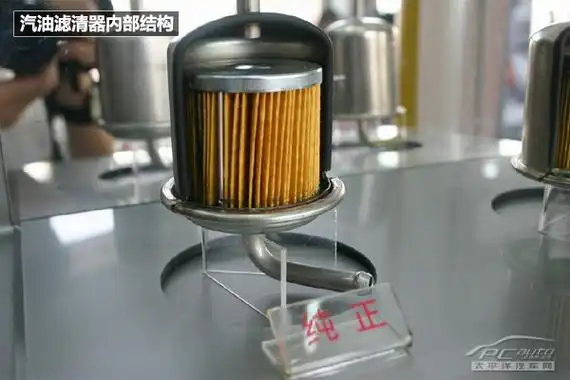The Importance of the Fuel System & Filter
The Importance of the Fuel System & Filter
The purpose of your vehicle's fuel system is to store and supply the gasoline or diesel fuel your engine needs to run. Your vehicle's fuel system is like the vascular system in your body: the fuel pump acts like the heart, the fuel lines act like the veins, and the fuel filter acts like the kidneys. A failure in any of these key fuel system components would result in the same devastating effects to your vehicle as a failure in any of the human vascular components would to your body.
The key fuel system components include the fuel pump, fuel gauge, fuel tank, fuel filter, fuel lines, and fuel injectors.

Fuel pumps can be in-tank or external. Modern electric fuel pumps are generally located inside the fuel tank. The fuel pump generates a constant flow of fuel to the engine, and fuel not used is returned to the tank. This reduces the chance of fuel getting too hot since it is never kept close to the hot engine for very long.
An in-tank fuel pump greatly reduces the risk of fire. Electrical components, such as the fuel pump, can spark and ignite fuel vapors, but liquid fuel will not explode. For this reason, positioning the fuel pump inside the tank, submerged in fuel, is the best placement for the fuel pump. Submerging the fuel pump in the cool fuel also helps prevent it from overheating. This extends the life of the electric fuel pump and is an important reason to maintain a minimum of a quarter of a tank of fuel in your vehicle.

The fuel tank is a reservoir designed to safely store fuel. While filling the fuel tank, fuel travels through a filler tube into the tank. This filler tube is usually sealed with a fuel cap. Always make sure your filler cap is sealed tightly as a loose or faulty fuel cap may often cause a vehicle's check engine light to come on. Inside the fuel tank, there is a sending unit which tells the fuel gauge how much fuel is in the tank, thereby ensuring that you know when your vehicle is low on fuel. Modern fuel tanks are more complex and contain emissions control components to prevent fuel vapors from evaporating into the atmosphere. The fuel pump has two purposes: to generate volume, and to generate pressure. The pressure delivered from the pump, as well as the volume of fuel, must meet the manufacturer's requirements to ensure the performance and emissions of the vehicle meet the required specifications. The pump creates positive pressure and draws fuel from the tank. The pump then pushes fuel through the fuel lines and fuel filter, delivering it to the fuel injectors at the engine. The fuel is then delivered to the cylinder combustion chambers and ignited. When your fuel system accomplishes this process, your engine can run. Pressurized and filtered fuel flows through the fuel lines to the engine and reaches the fuel injectors. Fuel pressure at the injectors is regulated by the fuel pressure regulator. Fuel injectors are used to spray controlled amounts of fuel and are activated when fuel is intended to be delivered to the engine. When the injector solenoid is activated, a plunger is pulled toward the solenoid with magnetic force. This uncovers the valve opening and allows fuel to flow into the atomizer and out the spray tip. When the solenoid is turned off, a valve spring attached to the plunger returns the plunger to its original position. An average fuel injector will perform this process millions of times.

Fuel filters are required to maintain a flow of clean fuel flowing to the engine. Some vehicles have two fuel filters, one inside the fuel tank and one in-line between the fuel tank and engine. Some vehicles only have one fuel filter integrated with the fuel pump module assembly. Fuel filters serve a critical function because unfiltered fuel may contain several types of contamination including rust, dirt, and debris. If not removed before entering the fuel system, these contaminants can cause damage to high-precision components. Fewer contaminants present in the fuel will allow the vehicle to burn fuel more efficiently. If the fuel filter becomes clogged, the fuel pump must work harder to pump fuel past the clog. This can result in damage to the electric fuel pump.

Modern fuel systems are complex and ultimately controlled by the vehicle's computer, which has helped vehicles reach amazing levels of fuel economy, reduced emissions, and increased engine performance. The systems are relatively maintenance free, but there are steps you can take to improve the life and performance of your fuel system. First, make sure you are using the fuel recommended by your vehicle's manufacturer. Second, if your vehicle has an in-line fuel filter, make sure you replace it at the recommended interval. Third, inspect your fuel filler cap to make sure it seals properly against the filler neck. Fourth, have your fuel injection system cleaned every three years or 45,000 miles by a reputable automotive repair shop with ASE certified technicians. If your vehicle has a replaceable in-line fuel filter, it is a good idea to replace it every 30,000 miles. An old appearance and rust are also good indications the fuel filter should be replaced. If you notice any symptoms such as hard starting, rough idling, hesitation, fuel leaks, fuel smells, or poor overall performance, have your vehicle's fuel system inspected by an ASE certified technician.

 EN
EN







































